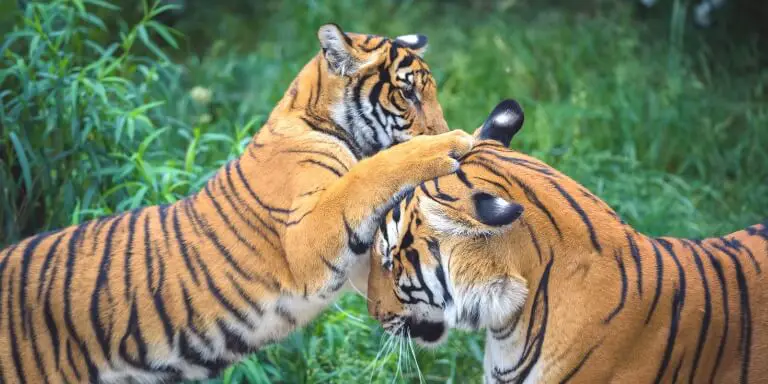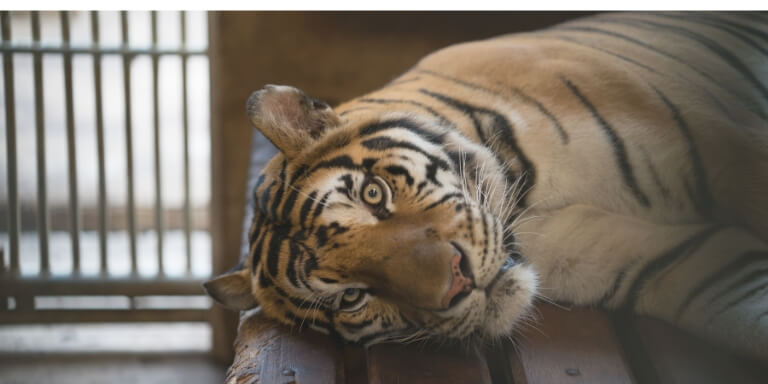The tiger is the largest member of the cat family. Understanding how long a tiger lives in the wild is crucial for conservation efforts.
Tigers naturally live for about 10-15 years in the wild. Tigers live much longer in captivity, usually 15-20 years due to better care and nutrition.
The oldest known tiger lived to be nearly 26 years! Despite their long lives, tigers face many threats in the wild such as habitat loss, poaching, and conflict with humans are dangers. By applying effective conservation efforts, we can help ensure tigers thrive for generations.

Lifecycle of a tiger
First Stage: Newborn
Newborn tigers are blind at birth and weigh between 2 and 3 pounds. They are completely helpless and depend on their mother for everything. Around the age of two, they begin learning to hunt and survive independently.

Second Stage: Child
As young tigers grow, they continue to hone their hunting skills while also learning to navigate social hierarchies and the dynamics within their pride. Around the age of three, they begin to leave their mother and become more independent.
Third Stage: Young
As young adults, tigers reach their full size and weight, becoming capable of mating and starting their own families. However, they remain subordinate to the older, more dominant tigers in their pride
Fourth Stage: Adult
The adult phase of a tiger’s life is marked by independence, dominance, and a focus on survival and reproduction. Typically, tigers reach adulthood between the ages of 3 and 5 years. During this phase, they are at the peak of their strength and hunting abilities, with males growing larger and more territorial than females.
Independence and Territory: Once a tiger reaches adulthood, it establishes its own territory. Males tend to claim larger territories than females. These territories are fiercely defended, especially against rival males, as maintaining control over their domain is vital for access to mates and resources.
Tigers mark their territory using scent markings, scratch marks on trees, and vocalizations such as roars to signal their presence.
Hunting and Survival: Adult tigers are solitary hunters, relying on their strength, stealth, and powerful build to take down prey. Adult tigers hunt by stalking their prey and launching a surprise attack, aiming for the neck or throat. A successful adult tiger can bring down prey much larger than itself, ensuring a steady supply of food to sustain its energy levels and maintain its territory.
Reproduction and Mating: Reproduction is a key focus during the adult phase. Tigresses become capable of conceiving in every 3 to 9 weeks, signaling their readiness to mate. Males will often fight for the right to mate with a receptive female. After a successful mating, the female gestates for around 3 to 3.5 months.
Interestingly, after mating, the male does not participate in raising the cubs, leaving the female to nurture and protect the young alone. Adult females, particularly those with cubs, may have slightly smaller territories, as their focus shifts from hunting to caring for their offsprings.
Lifespan and Aging: Adult tigers typically thrive in their prime years, which can last from 10 to 12 years in the jungle. As they age, tigers become less agile and may struggle to compete with younger rivals for territory and food. Eventually, their declining health leads to difficulty in hunting, and they become more vulnerable to other threats, such as poaching, injury, or disease.
How Long Do Tigers Live in the Wild?
In the wild, tigers typically have a lifespan of around 10 to 15 years, though some individuals have been known to live up to more than 15 years in exceptional cases. There are rare records of tigers reaching 20 years, but such longevity is uncommon.
Probable Causes of Death in the Wild
A tiger’s natural lifespan is often limited by several factors, including old age, malnutrition, and injuries from fighting with rivals. Competition for territory and mating rights often leads to violent encounters among tigers, especially males, which can result in severe injuries. Additionally, as tigers age, their ability to hunt effectively declines, often leading to starvation.

Tigers also face external threats such as poaching, habitat destruction, and human-wildlife conflict, all of which contribute to a shorter lifespan in the wild. Human activities have increasingly fragmented tiger habitats, reducing their access to prey and making survival more challenging.
High Mortality Among Cubs
Tiger cubs have an especially high mortality rate. It is estimated that only about 40-50% of cubs born survive to adulthood. The primary causes of cub mortality include predation, abandonment, and infanticide, where adult male tigers kill cubs to bring the mother back to mating.
Cubs are particularly vulnerable during their early months, and predators like leopards, wild dogs, and other large carnivores pose a significant threat. In addition, inexperienced mothers may abandon or fail to properly care for their young, further reducing survival rates.
Influence of Habitat and Prey Availability
The lifespan of a wild tiger is closely tied to its habitat quality and prey availability. Tigers living in environments rich in prey, such as dense forests or regions with abundant ungulate populations, tend to live longer due to a more reliable food supply. Conversely, in areas where prey is scarce, tigers are forced to travel long distances to hunt, increasing their risk of injury, malnutrition, and conflict with other predators or humans.
In protected reserves or national parks, where human interference is minimized and prey is plentiful, tigers often live longer and healthier lives compared to those in unprotected regions. The quality of their environment plays a crucial role in determining how long a tiger can thrive in the wild.
How Long Do Tigers Live in Captivity?
Tigers in captivity generally live longer than those in the wild, with most surviving between 15 and 20 years. While wild tigers typically live for 10 to 15 years, their counterparts in captivity often outlive them due to various advantages. In some cases, captive tigers have even reached the age of 25 or more, largely thanks to the controlled environment they live in.

Why Tigers Live Longer in Captivity
Protection from Predators and Threats: One of the primary reasons tigers live longer in captivity is that they are shielded from many of the dangers they face in the wild. In captivity, tigers do not have to compete with rivals for territory or mates, nor do they risk injury from fights. They are also protected from predators, starvation, and the environmental challenges that wild tigers endure.
Consistent Food Supply: Unlike wild tigers, which may face periods of starvation due to scarcity of prey, captive tigers are provided with regular, balanced meals. This reliable access to food helps them maintain a healthy weight and reduces the energy expenditure involved in hunting, contributing to a longer lifespan.
Veterinary Care: Captive tigers benefit from regular veterinary checkups and medical treatments that are unavailable to their wild counterparts. Injuries, illnesses, and other health conditions that could be fatal in the wild can often be treated effectively in captivity, significantly extending a tiger’s life expectancy.
Shelter from Harsh Weather In captivity: tigers are often housed in environments where they are protected from extreme weather conditions. Wild tigers, on the other hand, must endure intense heat, cold, rain, and other environmental stressors that can weaken their health over time.
Drawbacks of Tigers being captive
While captivity may extend a tiger’s lifespan, it comes with significant drawbacks that can negatively affect the animal’s physical and psychological well-being.
Restricted Space and Lack of Freedom: In captivity, tigers are often confined to enclosures that are much smaller than their natural ranges in the wild.
Wild tigers typically roam over vast territories, sometimes covering hundreds of square miles. The lack of space in captivity can lead to frustration, boredom, and stress, which may manifest in abnormal behaviors like pacing, aggression, or self-harm.
Lack of Mental Stimulation: Tigers are highly intelligent and curious animals that thrive in environments where they can explore and engage in natural behaviors like hunting.
In captivity, the absence of mental and physical challenges can lead to behavioral issues and poor mental health. Many captive tigers show signs of depression or anxiety as a result of a monotonous and unstimulating environment.
Harmful Training Practices: In some facilities, particularly circuses and tourist attractions, tigers are subjected to harmful and abusive training methods. These practices often prioritize entertainment over the well-being of the animals, leading to physical and emotional harm.
Tigers in such settings are at risk of injury and chronic stress, which can shorten their lifespan despite the controlled environment.
Oldest tigers in the world
Bengali, the world’s oldest tiger in captivity, was 26 years old at the time of euthanized due to declining health. Bengali far exceeded the typical lifespan for tigers.
She was brought to the sanctuary in 2000 after being rescued from a breeding facility and had become a beloved resident. Though shy when she first arrived, Bengali eventually grew comfortable, spending her days lounging, eating, and interacting with guests. Despite her long stay, she never had cubs.
Probable Causes of Tiger Death
A century ago, about 100,000 tigers roamed in the wild, but today that number of tigers has dropped to approximately 5,600 in the wild. This dramatic decline is due to several factors:
Poaching: The leading cause of tiger deaths. Tigers are hunted for their fur, bones, and body parts, used in traditional Chinese medicine. As demand for these products grows, poaching increases.
Aging: Tigers in the wild live 10–15 years. As they age, they struggle to compete for food and territory, making them more vulnerable to injuries, starvation, and disease.
Predators: While tigers are apex predators, they can still be killed by other large carnivores such as lions, leopards, and hyenas, often due to competition for territory or resources.
Environmental Factors: Human activity, including habitat destruction and fragmentation, significantly reduces the tiger’s natural living space, leading to conflicts with humans and food scarcity.
The tiger population is declining mainly due to poaching, but all these factors collectively threaten their survival. Without urgent conservation efforts, tigers may become extinct in the wild.
Conclusion
Tigers in the wild typically live 10 to 15 years, while in captivity, they can survive up to 20 years. As an endangered species, tigers face numerous threats, including habitat loss, illegal hunting, and human-wildlife conflict.
These factors, combined with poaching and environmental degradation, contribute to their population decline. Conservation efforts are crucial to protect these majestic animals and ensure their survival for future generations. The continued decline of tigers emphasizes the urgency of addressing these threats through global conservation initiatives.
You might also be interested in:
